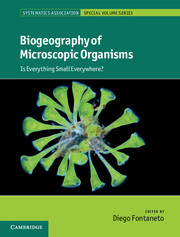Book contents
- Frontmatter
- Contents
- List of contributors
- Preface
- Part I Theoretical framework
- 1 Why biogeography of microorganisms?
- 2 Historical biogeography, microbial endemism and the role of classification: everything is endemic
- Part II Prokaryotes
- Part III Unicellular eukaryotes
- Part IV Pluricellular eukaryotes
- Part V Processes
- Index
- Systematics Association Publications
- Systematics Association Special Volumes
- Plate section
- References
1 - Why biogeography of microorganisms?
from Part I - Theoretical framework
Published online by Cambridge University Press: 05 August 2012
- Frontmatter
- Contents
- List of contributors
- Preface
- Part I Theoretical framework
- 1 Why biogeography of microorganisms?
- 2 Historical biogeography, microbial endemism and the role of classification: everything is endemic
- Part II Prokaryotes
- Part III Unicellular eukaryotes
- Part IV Pluricellular eukaryotes
- Part V Processes
- Index
- Systematics Association Publications
- Systematics Association Special Volumes
- Plate section
- References
Summary
The problem
The aim of this book is to discuss the idea that for microorganisms ‘Everything is everywhere’ (EiE hypothesis), that is, large organisms have biogeographies, whereas microscopic ones do not have any large-scale spatial pattern of distribution: microorganisms have no biogeographies.
Size is known to be among the supreme regulators of all biological entities. Shape of any organism is mostly a consequence of its size; how the organism interacts with the environment and all its biological functions are a matter of its size; its life history is influenced by its size (Calder, 1996; Bonner, 2006). The strongest correlate of body size is that body volume and body surface are not linearly related. Thus, larger organisms have different needs from small ones regarding temperature, osmosis, physiology, metabolism and many (if not all) other processes (Schmidt-Nielsen, 1984; Peters, 1986). Body size also determines what an organism may be able to do, even its extinction risk, and the communities and the ecosystems the organisms live and interact in (Colinvaux, 1978; Cardillo and Bromhan, 2001; Hildrew et al., 2007).
Most of these theories, hypotheses and models attempt to describe some continuous function relating biological patterns and processes with body size, and universal scaling laws in biology have been formulated and tested (Brown and West, 2000). A notable exception to this is the biogeographic implication of body size.
- Type
- Chapter
- Information
- Biogeography of Microscopic OrganismsIs Everything Small Everywhere?, pp. 3 - 10Publisher: Cambridge University PressPrint publication year: 2011
References
- 13
- Cited by



